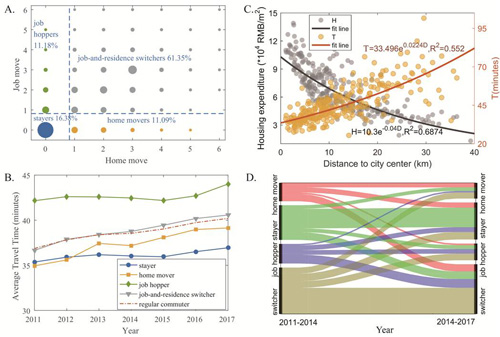Researchers Release Commutes Affect Our Job and Housing Dynamics
Job and housing dynamics are related to commutes of our daily life. Few longitudinal studies have examined their correlations. Now, a study reporting in PNAS on November 19 have investigated job and housing dynamics by various mobility groups.
The research team led by Prof. WANG Jiaoe and Dr. HUANG Jie from Institute of Geographic Sciences and Natural Resources Research, CAS, collaborating with Prof. David Levinson (University of Sydney), Dr. ZHOU Jiangping (The University of Hong Kong), and Dr. WANG Zi-jia (Beijing Jiaotong University). They used 7-year transit smartcards from cardholders in Beijing, China, to track boarding and alighting stations, which are associated with home and work location. Then the study tracked who moves and who remains at their residences and workplaces.
The study identified 4,248 commuters who made transit trips at least 4 days in one week over 7 years. The researchers found that individuals with commutes longer than 45 minutes changed workplaces or residences to reduce their travel time. On the contrary, individuals who commute shorter than 45 minutes tend to increase their travel time for better jobs and residences. Overall, 45 minutes is an inflection point where the behavioral preference changes.
Previous studies argued that residents who rely on transit commuting in a long term should be economically underprivileged. Here, researchers found that four mobility groups show diverse commuting patterns, residential profiles, and socioeconomic status. Stayers, individuals who remained at the same residence and workplace over 7 years, were more likely than other groups to have shorter commutes and to be home-owners with middle-to-high-range incomes.
Home movers, individuals who changed residences but remained at the same workplace, had middle-range incomes and upgraded from tenancy to ownership, which lengthened commutes. Switchers, individuals who changed both residences and workplaces tended to move into more expensive homes, which increased commute times. Switchers is a ‘coming-up’ group, as their job and housing patterns have converged to stayers’. Job hoppers, individuals who frequently changed workplaces but stayed at the same residences, suffered from long commutes and affordable housing issues. They tended to be migrants with temporary employment and low wages.
According to these finds, job and housing dynamics are useful in the mobility group characterization, and travel times can significantly influence job and housing choices.
The study is financially supported by the Strategic Priority Research Program of the Chinese Academy of Sciences and the National Natural Science Foundation of China.
 |
|
Fig. A. Classification of regular commuters; B. Average travel time in the subway system by groups; C. Housing expenditure (H) by distance to city center (D) and average travel time in the subway system (T); D. Variation of job and housing status.(Image by HUANG Jie) |
Reference: Jie Huang, David Levinson, Jiaoe Wang, Jiangping Zhou, and Zi-jia Wang. 2018. Tracking job and housing dynamics with smartcard data. PNAS. (https://doi.org/10.1073/pnas.1815928115)
CONTACT: WANG Jiaoe, Key Laboratory of Regional Sustainable Development Modeling, Institute of Geographic Sciences and Natural Resources Research, Chinese Academy of Sciences, Beijing 100101, China; e-mail: wangje@igsnrr.ac.cn
Download attachments: